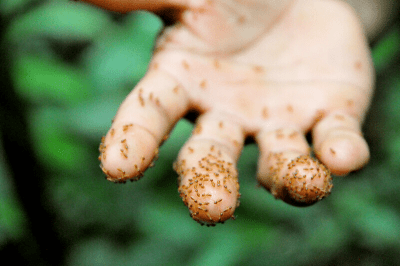 Owing to their wood-eating habits, many termite species can do significant damage to unprotected buildings and other wooden structures. Termites play an important role as decomposers of wood and vegetative material, and the conflict with humans occurs where structures and landscapes containing structural wood components, cellulose derived structural materials and ornamental vegetation provide termites with a reliable source of food and moisture. Their habit of remaining concealed often results in their presence being undetected until the timbers are severely damaged, with only a thin exterior layer of wood remaining, which protects them from the environment. Of the 3,106 species known, only 183 species cause damage; 83 species cause significant damage to wooden structures. In North America, 18 subterranean species are pests; in Australia, 16 species have an economic impact; in the Indian subcontinent 26 species are considered pests, and in tropical Africa, 24. In Central America and the West Indies, there are 17 pest species. Among the termite genera, Coptotermes has the highest number of pest species of any genus, with 28 species known to cause damage. Less than 10% of drywood termites are pests, but they infect wooden structures and furniture in tropical, subtropical and other regions. Dampwood termites only attack lumber material exposed to rainfall or soil.
Owing to their wood-eating habits, many termite species can do significant damage to unprotected buildings and other wooden structures. Termites play an important role as decomposers of wood and vegetative material, and the conflict with humans occurs where structures and landscapes containing structural wood components, cellulose derived structural materials and ornamental vegetation provide termites with a reliable source of food and moisture. Their habit of remaining concealed often results in their presence being undetected until the timbers are severely damaged, with only a thin exterior layer of wood remaining, which protects them from the environment. Of the 3,106 species known, only 183 species cause damage; 83 species cause significant damage to wooden structures. In North America, 18 subterranean species are pests; in Australia, 16 species have an economic impact; in the Indian subcontinent 26 species are considered pests, and in tropical Africa, 24. In Central America and the West Indies, there are 17 pest species. Among the termite genera, Coptotermes has the highest number of pest species of any genus, with 28 species known to cause damage. Less than 10% of drywood termites are pests, but they infect wooden structures and furniture in tropical, subtropical and other regions. Dampwood termites only attack lumber material exposed to rainfall or soil.
Drywood termites thrive in warm climates, and human activities can enable them to invade homes since they can be transported through contaminated goods, containers and ships. Colonies of termites have been seen thriving in warm buildings located in cold regions. Some termites are considered invasive species. Cryptotermes brevis, the most widely introduced invasive termite species in the world, has been introduced to all the islands in the West Indies and to Australia.
In addition to causing damage to buildings, termites can also damage food crops. Termites may attack trees whose resistance to damage is low but generally ignore fast-growing plants. Most attacks occur at harvest time; crops and trees are attacked during the dry season.
The damage caused by termites costs the southwestern United States approximately $1.5 billion each year in wood structure damage, but the true cost of damage worldwide cannot be determined. Drywood termites are responsible for a large proportion of the damage caused by termites. The goal of termite control is to keep structures and susceptible ornamental plants free from termites.; Structures may be homes or business, or elements such as wooden fence posts and telephone poles. Regular and thorough inspections by a trained professional may be necessary to detect termite activity in the absence of more obvious signs like termite swarmers or alates inside or adjacent to a structure. Termite monitors made of wood or cellulose adjacent to a structure may also provide indication of termite foraging activity where it will be in conflict with humans.
Source: https://en.wikipedia.org/wiki/Termite
Termites can be controlled!
The professionals at Zap Pest Control can eliminate your termite problems for good and recommend required repairs form the damage they caused. Contact Us today to make an appointment: 610-565-4151
Sign up to our Newsletter
(We do not share your data with anybody, and only use it for its intended purpose)

